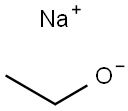Chemical Properties
White powder, sometimes having
brownish tinge; readily hydrolyzes to alcohol and
sodium hydroxide.
Physical properties
White or yellowish powder; hygroscopic; darkens and decomposes on exposure to air; decomposes in water forming sodium hydroxide and ethanol; dissolves in absolute ethanol.
Uses
Sodium ethoxide is used in organic synthesis for condensation reactions. It also is a catalyst in many organic reactions.
Uses
Sodium ethoxide, 21% w/w in ethanol is used as a strong base in organic synthesis. It finds application in various chemical reactions such as condensation, esterification, alkoxylation and etherifcation. It is actively involved in Claisen condensation, Stobbe reaction and Wolf-kishner reduction. It is an important starting material for the synthesis of ethyl ester and diethyl ester of malonic acid. In Williamson ether synthesis, it reacts with ethyl bromide to form diethyl ether.
Definition
ChEBI: An organic monosodium salt that has ethoxide as the counterion.
Preparation
Sodium ethoxide is prepared by reacting sodium with absolute ethanol:
2Na + 2C2H5OH → 2C2H5ONa + H2
Sodium in small quantities is added to absolute alcohol at 10°C. The temperature is raised to warming (to about 38°C). The mixture is cooled again and sodium and absolute alcohol are added gradually followed by careful warming. The process is repeated to obtain a sufficient yield of the p
General Description
Sodium ethoxide is an alkoxide salt mainly used as a strong base in organic reactions such as deprotonation, dehydration and dehalogenation.
Hazard
As for caustic soda, ethanol. Sodium
hydroxide is formed when sodium ethylate is
exposed to moisture.
Flammability and Explosibility
Highly flammable
Purification Methods
It is a hygroscopic powder which should be stored under N2 in a cool place. A likely impurity is EtOH which can be removed by warming at 60-80o under high vacuum. It is hydrolysed by H2O to yield NaOH and EtOH. Other impurities, if kept in air for long periods are NaOH and Na2CO3. In this case the powder cannot be used if these impurities affect the reactivity, and a fresh sample should be acquired [IR: Seubold J Org Chem 21 156 1956]. [Beilstein 1 H 311, 1 IV 1289.]






